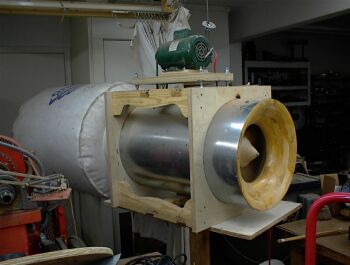 The
impeller is a cone fabricated from a disc of 1/2" baltic birch 15" in diameter,
with rings of 1/2" birch glued to the disc. Each ring is cut at a
45 degree angle on the outside and inside and are 1" wide. The smallest
ring is 5" in diameter. The remainder of the cone is a glued-up wooden
removable member. This is to allow access to the interior of the
cone to enable it to be bolted to a flange on the shaft. The flange
and shaft were shop-fabricated. Well, the entire thing was shop-fabricated!!
The
impeller is a cone fabricated from a disc of 1/2" baltic birch 15" in diameter,
with rings of 1/2" birch glued to the disc. Each ring is cut at a
45 degree angle on the outside and inside and are 1" wide. The smallest
ring is 5" in diameter. The remainder of the cone is a glued-up wooden
removable member. This is to allow access to the interior of the
cone to enable it to be bolted to a flange on the shaft. The flange
and shaft were shop-fabricated. Well, the entire thing was shop-fabricated!!
Vanes are 3" wide, and as long as the slope on the cone, minus the removable
nose piece. They are made from 1.7 mm plywood (very thin) and were
epoxied into 1/8" deep grooves cut in the face of the cone. The outer
part of the impeller is a 'shroud' fabricated from 2-ply veneer.
Two layers of this veneer were epoxied to the outer edges of the vanes,
then one layer of fiberglass cloth was applied to the outside of the shroud
for strength. A coating of epoxy was applied to all surfaces of the impeller
for abrasion
resistance.
I had previously made an impeller from steel plate, but it was so heavy that it took an appreciable time to come up to speed. This version was made from wood because of its light weight.
The motor is a 1 hp 1725 rpm TEFC 120 volt unit. It drives the shaft of the blower via a 1/2" v-belt. The pulleys are both adjustable width (therefore diameter) and were selected so that I could adjust the speed of the impeller until the motor was drawing its rated amperage, thereby insuring that the full hp was utilized. Also, to make sure that I wasn't overloading the motor.
The dust collection bag is a felt unit from Oneida, which has the best
rating available to me. IIRC, it captures dust down to 5 microns.
Much better than the standard 30 micron units. Also, since it fits
a 20" housing, this was a determining factor in arriving at the diameter
of the housing.

The inlet ring was stack laminated from 2x4s. It was then mounted on a large faceplate and turned to shape. The shape is elliptical and a template was used to insure accuracy. This insures that the airflow is consistant across the entire 20" opening. It too was coated with epoxy.
Turning vanes are utilized inside the housing behind the impeller to stop the airflow from spiraling down the housing. By making the air flow straight back, pressure is increased and the air exits the housing in the shortest amount of time.
The bag was designed to work with a pressure of 1" of water. Checking with a manometer reveals that I am just short of 1", so in order to achieve that pressure I would need more hp, probably 1 1/4. If I ever replace the motor, I will do so with a 1 1/2 hp unit, and increase the speed of the impeller, which now runs about 1140 rpm.
Aside from being a bit noisy, I am totally satisfied with the performance
of the dust collector. But it is a monster. Fortunately I have
room behind my lathe for it, as long as I clear off the workbench so the
bag will have someplace to go.
| Home | The Present | The Family & Stuff | Cool Links (IMHO) |
| Closed Forms | Canisters | Misc. Thingies | The Shopsmith Years |
| Bowls | Shop Stuff | Projects |